Rebecca S. Ramsey's Blog, page 19
October 7, 2019
The Ark and the Tent
 Welcome to the Ark and the Tent, the Godly Play story scheduled for this Sunday, October 13, based on Exodus 25-31, 35-40. You can find the script on p.81-86 in the orange book (The Complete Guide to Godly Play, Vol 2, 14 Presentations for Fall, by Jerome W. Berryman).
Welcome to the Ark and the Tent, the Godly Play story scheduled for this Sunday, October 13, based on Exodus 25-31, 35-40. You can find the script on p.81-86 in the orange book (The Complete Guide to Godly Play, Vol 2, 14 Presentations for Fall, by Jerome W. Berryman).
Children always get so excited about this story. They love the little pieces belonging to the tent, I think partly because each piece comes with a tradition. We all know how kids LOVE traditions–knowing the proper way to do things and the reasons behind why we do them. Bringing a sacrifice for the altar, washing at the laver before entering the tent, burning incense, placing 12 pieces of bread on the table, lighting the menorah…it all has meaning, centered upon being ready to meet God.
There are different approaches to this lesson that teachers can take. Of course we can all go through a study of each of the steps of getting ready and the tools mentioned above to help them get ready. Many churches still use several of these today. Are there any that we use? Are there new ones not included with the tent?
We can also think about how we get ready to do different things in our lives–to go places that are important to us, for example. How do we get ready to hear our Godly Play stories? Why is that important? How do we get ready to be with God? What do we do? How exactly do the routines we do help us get ready? Can we practice getting ready to be with God when we’re at home too? How would we do that?
One thing that the Godly Play script doesn’t highlight which you may want to include is the idea that all the people of God were invited to give something of their own to creating the tent of meeting–not just jewelry or fabric or wood, but their own craftsmanship. It was created by the people of God, for God.
Ideas for Art Response Time
This story is practically BURSTING with ideas for little hands–and big ones too!
I can easily see the activity time for this story beginning this Sunday, but continuing at least one other Sunday. Soon we’ll do the Ark and the Temple, so the work could easily continue with that story too.
Here are some that I came up with to add to your own. (And please, do feel free to write a comment to share your own ideas!)
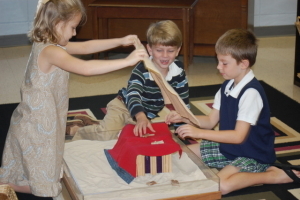


Children might like to make their own collection of getting ready pieces like a menorah, an incense holder, a laver, an ark. They could make tiny pieces with clay or boxes or pieces of wood or whatever materials we have.
Or they could spend more time on making individual pieces. The menorahs above are made from a big clay “worm” in which popsickle sticks (which have been colored with crayons) are inserted. Sequins and beads have also been pressed into the clay.
Here are some websites with more great ideas and directions:
How to make a potato menorah:
www.jewishappleseed.org/apple/potatomenorah.htm
How to make a menorah from clay:
www.familyfun.go.com/crafts/clay-menorah-666608/

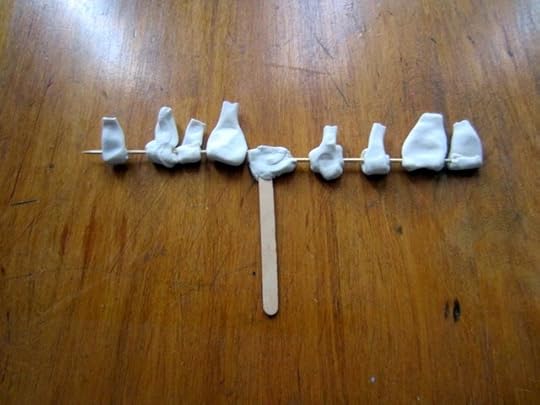
Of course our children will come up with more creative ideas than we can!


Some things to ask them:
How could we make a laver?
What do we have in our classroom which might make a good altar?
A table for the 12 slices of bread?
An ark of the covenant? How about decorating a box with gold wrapping paper for the ark?

What about the poles that carry it?
(Wouldn’t it be fun to light some incense and see what it smells like?)

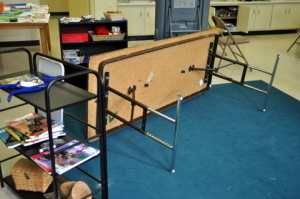
If we’re going to make all those pieces, why not make a tent of meeting in which to put them?
A table turned on its side could give us the framework.
There are a few tablecloths folded up in the art supply room to serve as the tent fabric.

What if we brought blankets from home? We could even have a four layer tent, much like the tent is described in the Bible.
Once the tent is made, we could put all the pieces we created inside it. How would we separate the Holy of Holies?


Or we could make a small tabernacle out of cardboard and fabric.
There’s so much to think about. I can’t wait to see what your classes create! If you take photos, please share them with me. I’d love to add them to the parent newsletter!
Have fun, y’all! And for more ideas, including snack ideas for the lesson, see my Pinterest page on the story, here.
October 5, 2019
World Communion Sunday 2019
 This children’s sermon was written for World Communion Sunday, October 6, 2019.
This children’s sermon was written for World Communion Sunday, October 6, 2019.
Good morning girls and boys! I brought one of my favorite books with me today that reminds me of what we’re celebrating today in worship, in a way. It’s All Are Welcome, by Alexandra Penfold. It’s about school, but when I read it, it reminded me of church. So I’m going to read part of it and when you hear a part that reminds you of church, wave your hand.
So what sounds like church to you?
Today is World Communion Sunday, a day when people all over the world come to Jesus’ table and remember him through the bread and the wine/juice. We remember him and we give thanks that we are all welcome at God’s table, no matter what we wear when we play or if we come from far away. We can celebrate that we can be with God here, “where fear is lost and hope is found”, where we worship God with music and with art, where we share stories from God’s heart–where we’re part of God’s community and our strength is our diversity. We’re all different, but we all are God’s children.
You are welcome here. It’s such an important thing to know. You are home. This is home! God is your home!
Let’s thank God with a prayer: Dear God, we thank you that no matter how far we go in the world, you are with us. Thank you that you welcome all, that you make a space for everyone. As people all over the world come to your table today, help us remember to make room for others in our lives too. We love you, God. Amen.
September 30, 2019
The Ten Best Ways
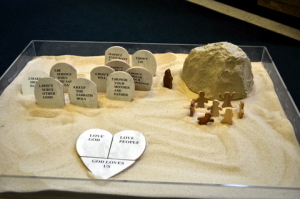 Welcome to The Ten Best Ways, our Godly Play story for this coming Sunday, October 6. You can find the story in Exodus 20:1-17, Deuteronomy 5:1-21. The Godly Play script can be found in the 14 Presentations for Fall book (the orange one), p. 73-80.
Welcome to The Ten Best Ways, our Godly Play story for this coming Sunday, October 6. You can find the story in Exodus 20:1-17, Deuteronomy 5:1-21. The Godly Play script can be found in the 14 Presentations for Fall book (the orange one), p. 73-80.
I love that Godly Play refers to the Ten Commandments as The Ten Best Ways and places them in a heart shaped box. This helps us remember that our God is not a supreme dictator who exists just for the chance to squash us when we don’t adhere to his rules, but is instead a God who loves us enough to want to give us boundaries, so that we can fully enjoy the life God meant for us.
In preparation for teaching the lesson, it’s good to look back at the session that precedes it: the Exodus. God has led his people out of slavery, away from Pharaoh and the soldiers chasing after them, through the sea, into freedom. Now they can live where they want, do what they want, be who they want. As the story script says, “Now that the people are free…where will they go now? What is the best way?”
Thank goodness (and thank God!) that God provided divine guidance, motivated completely by love.
What to focus on? Here are some general ideas :
1. The younger classes (first grade and younger) might choose to keep things simple by focusing on the first heart in the box: Love God, Love People, God Loves You. Or, depending on the children, you could go deeper and study all the commandments. You probably have an idea of what the children can handle best.
2. Study each of the commandments by reproducing them in some way.
3. Explore the idea of Moses being the only one with the courage to climb up into the fire and smoke to meet God. Children will find it interesting that God wanted to protect Moses from his powerful presence, so God put him in a crevice in the rock and put his hand over him until he had passed by, allowing Moses to see his back. I love the line, “When we see God’s back, we can follow God all of our days.”
4. The older children may benefit by exploring the conflict that comes when we find ourselves stuck between two commandments, like when Grandma gives you a present that you don’t like and asks you what you think of it. How do we love others and still stay true to the truth?
We should also address more close to the heart conflicts, like divorce. Many of our children are experiencing divorce and will be listening especially to the Best Way of honoring marriage. We need to be sure to include in our session a focus on grace and forgiveness. Sometimes people try their very best to honor the Ten Best ways, and it just doesn’t work out. God always offers love and forgiveness to all. His love never stops, no matter what.
Art Response Ideas:
* Give the children big construction paper hearts divided into the sections Love God, Love People, and God Loves You. “I wonder how you could illustrate each section?” Children could choose whether to draw or cut pictures from a magazine or paint with watercolors. Or children could work together on one huge heart of butcher paper, contributing illustrations for each section. (This idea is especially for the younger children.)
 *Let each child make a set of commandments, painting the tablets with watercolors after they write their version of the Ten Best Ways. It’s beautiful…see here.
*Let each child make a set of commandments, painting the tablets with watercolors after they write their version of the Ten Best Ways. It’s beautiful…see here.
*See this version done on slate.
* I wonder if we could make a Mount Sinai? (With a cleft for Moses to hide in!) Could we make Moses out of a clothespin? How would we make the Ten Best Ways?” The youngest children might need ideas from which to choose.
 *Could we make a huge set of Ten Best Ways together for our classroom? As tall as a child? Could we illustrate each commandment? Which one would you like to work on?
*Could we make a huge set of Ten Best Ways together for our classroom? As tall as a child? Could we illustrate each commandment? Which one would you like to work on?
 *I wonder what materials we might use to make individual sets of Best Way hearts, so that you can take it home with you. (You might want to see what kind of interesting materials you can find at a craft store. Save your receipts and I’ll reimburse you.)
*I wonder what materials we might use to make individual sets of Best Way hearts, so that you can take it home with you. (You might want to see what kind of interesting materials you can find at a craft store. Save your receipts and I’ll reimburse you.)
*I wonder if you can make up hand motions to illustrate each individual Best Way? Could you split them up among children and videotape each one, making a video the whole class can enjoy? (If somebody does this I’d love to share it with parents!)
 *I wonder which is your favorite commandment? Would you like to concentrate just on that one, making a 2 dimensional or 3 dimensional representation of it? (a drawing or collage or making a scene out of play clay, etc?)
*I wonder which is your favorite commandment? Would you like to concentrate just on that one, making a 2 dimensional or 3 dimensional representation of it? (a drawing or collage or making a scene out of play clay, etc?)
Obviously, we wouldn’t want to present ALL of these options to the class, as that might be too overwhelming. But it’s a list I hope will help you…and get you started thinking of your own ideas.
And if you’d like more ideas, check out my Pinterest page on the Ten Best Ways, here.
Enjoy!
September 23, 2019
The Exodus
 Welcome to our lesson for Sept 29, The Exodus, found in Exodus 11:1-15:21. The Godly Play script is in the yellow (Fall) book, p. 65-72.
Welcome to our lesson for Sept 29, The Exodus, found in Exodus 11:1-15:21. The Godly Play script is in the yellow (Fall) book, p. 65-72.
When we left Moses last week, he was getting ready to go with Aaron to speak to the Pharaoh and to do what God told him to do: set the people free. Would he have the courage? Would God help him? How would it all play out? This week we get to celebrate the answers to these questions.
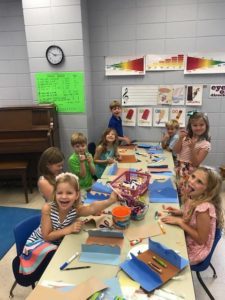
I would suggest telling the story as the script describes, and then, when Moses enters the scene, recap last week’s story before moving on, so that children can connect the two stories.
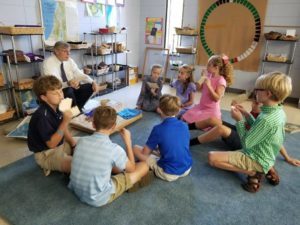 If you’re up for it, you might want to consider celebrating the story with an exploration of the seder meal, as described below. If you’re not up for that, I’ll have matzo for each classroom for the children to try.
If you’re up for it, you might want to consider celebrating the story with an exploration of the seder meal, as described below. If you’re not up for that, I’ll have matzo for each classroom for the children to try.
I’ve changed the wondering questions a little bit:
1. I wonder what part of the story you like the best.
2. I wonder what part is the most important.
3. I wonder if you were one of God’s people, how you might have felt when the Pharaoh set you free to follow Moses.
4. I wonder what you might have felt as you saw the sea part and a path emerge.
5. I wonder what part of this part of this story is about you, or what God is teaching you about Himself in this story.
Create a Gift for God Time
1. Children could recreate the story scene of the crossing of the Red Sea. Let children decide how they want to recreate this. They could make the pieces of the story- like the chain, the felt water that can be parted, the people, etc.
There’s an amazing example here. Take a look!
Here’s another example.
I’ll have blue paper and felt.

2. Children could work together to create a long chain, symbolizing the slavery the people of God had to be freed from. Here’s a pic of last years chain from 2nd grade.

Flickr photo of the seder courtesy of Imaginary Girl, through creative commons
 3.This would be a perfect time for the children to celebrate the seder meal. We did this in VBS a few summers ago and the children might remember enough to teach you about it! Just bring me a clean receipt and I’ll be glad to reimburse you. The meal is so full of meaning, all centered around this story.
3.This would be a perfect time for the children to celebrate the seder meal. We did this in VBS a few summers ago and the children might remember enough to teach you about it! Just bring me a clean receipt and I’ll be glad to reimburse you. The meal is so full of meaning, all centered around this story.
Here’s a guide with a simple explanation.
This allows our children to experience the Passover in a small way.
4. Children could make an instrument like Miriam might have used to celebrate the exodus. Look here for an example of a paper plate shaker. Let the children decorate it as they wish. We have paper plates and may have jingle bells, as well, in the art resource room if you want to use them.
For more art ideas, check out my Pinterest page, here.
Thanks y’all, for helping our children not only hear the story of the Exodus, but participate in it as well!
Love, Becky
September 16, 2019
The Story of Moses: The Beginning
 Welcome to our lesson for September 22, The Story of Moses, found in Exodus 1:8-17:7, 19:1- 40:38. The script is adapted from the story found in the pink Enrichment Presentations for Fall book, p.58-65. Sunday school teachers, I will emailed you a copy of the adapted script. If you’d like a copy and you’re not at FBG, feel free to email me and I’ll try my best to send it out to you.
Welcome to our lesson for September 22, The Story of Moses, found in Exodus 1:8-17:7, 19:1- 40:38. The script is adapted from the story found in the pink Enrichment Presentations for Fall book, p.58-65. Sunday school teachers, I will emailed you a copy of the adapted script. If you’d like a copy and you’re not at FBG, feel free to email me and I’ll try my best to send it out to you.
What an exciting story- and one children always love. Perhaps as we think about Moses’ humble beginning, our children will reflect on their own beginnings and know that they can be used by God to do great things for God’s kingdom as well. Most all of us can identify with not feeling up to the task or equipped to serve God. Moses’ story shows that willingness is all that it takes, that God will take care of the rest.
The timing of this story works well too with our story schedule, since we just shared the lesson of Joseph and will cover the Exodus story next. This adapted script ends right before Moses goes to talk with the Pharaoh, so the Exodus story can be shared as written in its Godly Play script. Be sure to end this story helping the children enjoy the suspense for next week’s lesson. It would be wonderful for them to go home asking what happens next, and reflecting on the story of the day.
Here are the wondering questions:
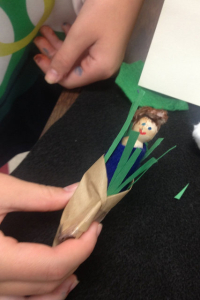 1. I wonder what was your favorite part of today’s story?
1. I wonder what was your favorite part of today’s story?2. I wonder what was the most important part?
3. I wonder if Moses ever made bad choices. I wonder if God can use people who sometimes make mistakes.
4. I wonder how Moses felt when God told him that God wanted Moses to set the people free from slavery.
5. I wonder what Moses did to get ready to speak to the Pharaoh about setting the people free.
What fun the children will have in our Make A Gift for God Time!
Here are some ideas to get the children started in planning their work:
1. Children can recreate the Moses in the Reeds scene, as shown here. (Scroll down to the part showing Moses in an Egg Carton Cup) Children can make their own basket and baby Moses using an a cup cut from an egg carton or paper bag- and whatever they like to make Moses (paper or a cotton ball for a head, felt for a blanket, etc). Blue construction paper could be the river and green for the reeds. They could even make the rest of the materials in the Godly Play story basket: a paper chain, a shepherd’s crook, the burning bush.
So that they get more invested in their work, allow them to make as many choices as to how they create the scene as possible.
I’ll have egg cartons, cotton balls, felt, and construction paper on hand on the cart at the end of the hall. Be sure to take photos of their work! [image error]
September 13, 2019
When Life Isn’t Fair
 This children’s sermon was written to accompany a sermon September 1, 2019, based on Amos 8:4-7. The whole children’s sermon idea (and art choice) comes from Carolyn Brown’s post on her wonderful site, Worshiping with Children. Thank you, Carolyn!
This children’s sermon was written to accompany a sermon September 1, 2019, based on Amos 8:4-7. The whole children’s sermon idea (and art choice) comes from Carolyn Brown’s post on her wonderful site, Worshiping with Children. Thank you, Carolyn!
Good morning, girls and boys. I brought something to show you today. It’s a painting by a Flemish painter a long long time ago. I wonder what you see when you look at it.
What differences do you see between the two men?
Look at their faces. I wonder what they’re thinking.
I wonder if you’ve ever felt anger over things not being fair.
I wonder if it’s okay to be angry. Yes, I think so. Anger when things are unfair makes us want to do something about it.
You’re not the only person that feels angry when things aren’t fair. Listen again to today’s scripture.
The Lord said:
4 You people crush those in need
and wipe out the poor.
5 You say to yourselves,
“How much longer before the end
of the New Moon Festival?
When will the Sabbath[b] be over?
Our wheat is ready,
and we want to sell it now.
We can’t wait to cheat
and charge high prices
for the grain we sell.
We will use dishonest scales
6 and mix dust in the grain.
Those who are needy and poor
don’t have any money.
We will make them our slaves
for the price
of a pair of sandals.”
7 I, the Lord, won’t forget
any of this,
though you take great pride
in your ancestor Jacob.[c]
It sounds like God is angry too. It sounds to me like God is asking us to do something about it.
Let’s pray.
Dear God, when people are not treated fairly by others, help us remember that we are the people you call to work to make things right. Help us figure out ways, little ways and big ways to bring justice to your world. We love you, God. Amen.
September 9, 2019
The Story of Joseph
 Welcome to the Story of Joseph, found in Genesis 37:1-31 and 49:1-6. (The script is found in the pink Enrichment Presentations for Fall book, p.51-57.)
Welcome to the Story of Joseph, found in Genesis 37:1-31 and 49:1-6. (The script is found in the pink Enrichment Presentations for Fall book, p.51-57.)
Since we just presented the Story of Jacob last week, this is the perfect time to talk about Jacob’s son Joseph. This story will help the children answer the question of how the people of God moved to Egypt and became slaves–which will help the Moses story and the Exodus story make more sense.
I’m sure that the children will find many parts of the story interesting- like the idea of Joseph being the favorite son, the sibling rivalry between the brothers, the enslavement and imprisonment of Joseph, the idea that dreams mean something, and the repairing of the relationship between Joseph and his brothers.
Ideas for our Make A Gift for God Time:
 Children could recreate the story in some way. Please remember that the activity will mean more to the children the more choices they have in how they decide what “work” to do and how they will accomplish it.
Children could recreate the story in some way. Please remember that the activity will mean more to the children the more choices they have in how they decide what “work” to do and how they will accomplish it.
1. Children could make a coat of many colors.
There are lots of ways they could do this. Several are described here. If the children want to make a coat of construction paper and trimmings, I’ll have construction paper, rickrack, buttons, etc on our cart at the end of the hall.
2. You could let the children pick scenes from Joseph’s life to draw out and put them together to make a mural of the different scenes. You could include in these the dreams he interpreted. We have plenty of huge mural paper.
3. Kids could make Egyptian costume pieces and act out parts of the story. Costume pieces are shown here. We have all sorts of fabric, beads, card stock, etc for the costumes. I’ll pull some to have on the cart on the hall.
4. You could also help the children explore what God is teaching us through Joseph’s story–how he mends his relationship with his brothers, despite everything, how he remains faithful to God in the middle of his troubles, and how God uses Joseph throughout his life. Could the children sketch and then paint with water colors ( or use marker or crayon) the scene of Joseph reuniting with his brothers? Maybe this could be a class project. Watercolors will be on my cart.
5. Don’t forget that one choice for a child’s work can always be to retell the story (using the materials that the teacher used) to another child. They love to handle the materials themselves and can use the laminated card to check themselves, to make sure they include all the parts of the story.
For more ideas on directions children can take with art response, see my Pinterest page here.
Enjoy!
September 3, 2019
The Story of Jacob
 Welcome to our lesson for September 8, The Story of Jacob, found in Genesis 25-33,35. (The script is found in the pink Enrichment Presentations for Fall book, p.44-50.)
Welcome to our lesson for September 8, The Story of Jacob, found in Genesis 25-33,35. (The script is found in the pink Enrichment Presentations for Fall book, p.44-50.)
What a perfect time to present this story. When we finished last week’s story, The Great Family, Isaac and Rebekah were married, Abraham died, and we shared that Isaac and Rebekah had children-who had children, who had children, etc. So who were their children? We can pick up right here with the Story of Jacob, ending with the formation of the 12 tribes of the Great Family, Israel.
Jacob’s story is so rich with topics that children will want to explore, like sibling relationships, fairness and trickery, making choices, the concept of a blessing, the idea of wrestling with God. Hopefully there will be plenty of time in your wondering time to hear their thoughts on these and to help them explore their own ideas.
Ideas for their Give a Gift to God Time
1. Recreate some of the story materials so that the children can tell the story themselves at home.
A bowl can easily be made out of quick dry clay, a ladder could be made from popsickle sticks, veils from netting. Children can come up with their own ideas of how to make the objects if they have access to materials.
2. Act out the story!
Our children LOVE doing this. Why not break the story into scenes and let the children act them out? Simple props could be a bowl, the animal skin from the story basket, and netting for a veil (I’ll have some in the resource room.) I’ll have my camera ready to borrow to video if you like.
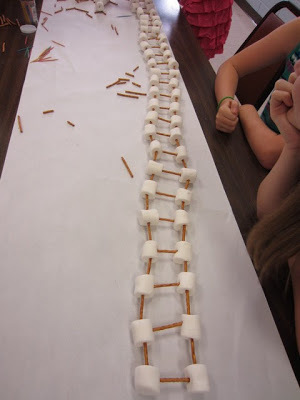 3. Make a Jacob’s ladder snack out of marshmallows, pretzels and marshmallow cream, as described hereYum!
3. Make a Jacob’s ladder snack out of marshmallows, pretzels and marshmallow cream, as described hereYum!4. Teach the children how do to Jacob’s ladder with a piece of string, as shown in this video.
While you’re practicing, talk about what the dream meant.
See more ideas at my Pinterest page on the story of Jacob, here.
Enjoy!
August 26, 2019
The Great Family
 Welcome to our lesson for September 1, The Great Family, found in Genesis 12-15, 24. (Script is found in the yellow Fall book, p.57-64.)
Welcome to our lesson for September 1, The Great Family, found in Genesis 12-15, 24. (Script is found in the yellow Fall book, p.57-64.)
What a meaningful lesson, to learn that we are all descendants of God’s great family, and that God is with us no matter where we go. The wondering questions are at the end of the script. I’ll be especially curious to hear how the children respond to the wondering question, “I wonder where you are in the story or what part of the story is about you?”
Idea Starters for the Give a Gift to God Time:
1. Stars! Check out these GORGEOUS stars shown here, which would be easy for all ages to make. Children could write on the other side a Bible verse from this story, perhaps Genesis 15:5 “ See the many stars. There are so many you cannot count them. Your family will be like that.”
Or make a moon and star like this: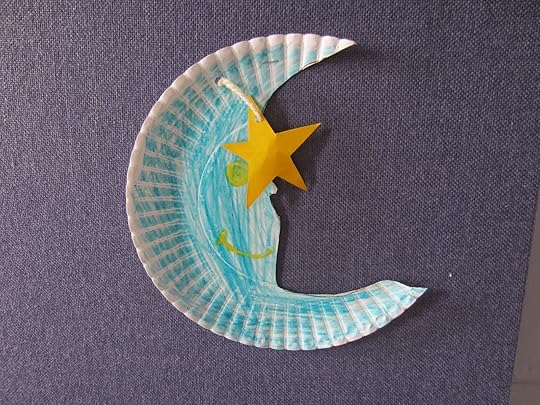
Or let the children figure out how they’d like to make a star of their own.
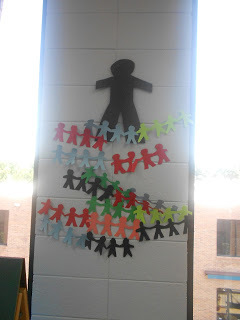
2. The beginnings of the great family: make Sarah and Abraham and Isaac out of play clay or clothespins. Or make finger puppets of the family. (Plenty -hundreds- of clothespins are in the art resource room in a cardboard box.
3. Each child individually- or all children together- could make a drawing of their part of the great family– their birth family and church family, all on one piece of butcher paper.
4.Sand drawings or sand art – to remember the desert in the story. Make a simple drawing- or the child’s name written in cursive- and cover the lines with glue, (I have new glue bottles in my office) then sift colored sand over the glue. The glue will stick to the sand. Children could also include names of others in their family.
5. Act out the story: Abram and Sarai walking toward Haran, sleeping in their tent, walking along the Euphrates, Abram being with God and knowing God wanted them to move on, Abram building an altar in Shechem and then in Bethel and Hebron, God’s promise to Abram, Sarah hearing she would have a son and laughing, Isaac and Rebekah.
6. Make a door hanger to commemorate Abram and Sarai’s willingness to go where God led them. You could use 1 John 5:3: This Is Love for God:to Obey His Commands.
7. Let children who wish to make a map of the area of the story.
For more art response ideas, see my Pinterest page, here.
Enjoy!
August 22, 2019
Peace Be Upon You! (For a Back to School Sunday)
 This Children’s Sermon was given on Promotion Sunday, August 18, 2019, the Sunday before most of our kids start back to school. It was also written to go with the sermon of the day, based on John 5:1-18, titled, “Malpractice”
This Children’s Sermon was given on Promotion Sunday, August 18, 2019, the Sunday before most of our kids start back to school. It was also written to go with the sermon of the day, based on John 5:1-18, titled, “Malpractice”
See below for the information needed to make a backpack tag, as well as the design. This would be great for a Blessing of the Backpacks. Though we didn’t have the actual backpacks in worship, we did bless the kids. They were excited to get a tag for their backpacks!
Good morning girls and boys. I want to especially welcome our new first graders who may be here for the first time! I’m so happy you’re here!
I believe I heard that something BIG happens this week to most of you! Yes, school begins. It’s the chance to start a new year. That’s exciting, and it’s normal to also feel a little nervous. Are there traditions that your family does to help celebrate? To help you find peace in all the newness?
It’s good to remember that God will be there to help keep you calm, if you ask God. It’s good to have parents and others to help you find peace.
But I’ve got a question for you. What if YOU’RE the person who’s supposed to bring God’s peace to others? In fact, God calls us to be a peace bringer- a peace maker. Even to new teachers and your parents! I have something for you, that I hope will help you remember that. You can put it on your backpack or your lunch box to remember it if you want.
I’d like to give you a blessing first and then I’ll hand them out and we’ll go back to our seats.
Dear God, we ask for your blessing on all of our students in this room- and for the teachers too. Help them to feel a closeness to you as they go into their classrooms. Open their hearts and minds to new friends and teachers. Help them to be brave and generous to everyone around them, showing them your love, your comfort and your peace. Inspire them to do their best and be their best. We love you, God. Amen
The design comes from Illustrated Children’s Ministries, and you can find it and download here. We put our church logo on the back, with the help of the Avery template, here. We didn’t buy the business card paper- I just printed them off on card stock, double sided.
After you purchase and download and print your tags, you’re ready to laminate them. I plan on doing different tags each year, so I went ahead and purchased this small laminator at Staples, here. And I also purchased several sets of ready to laminate luggage tags, like the ones shown here. I was surprised how easy these are to make.
Blessings to you! [image error]



